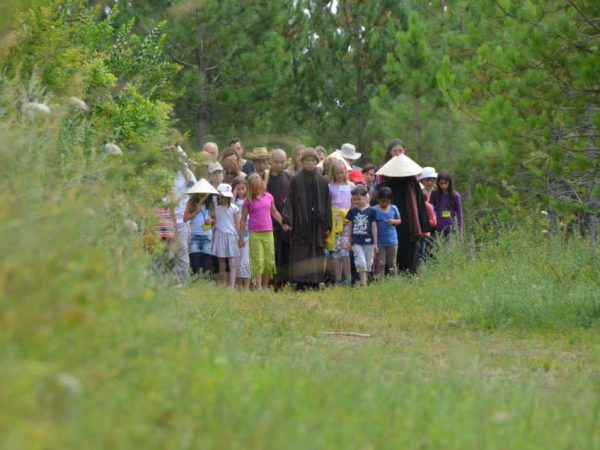We all know that coal, oil, and gas are quick, cheap, and readily available energy sources for driving, heating, and cooking. Solar, wind, and geothermal are less immediately available and will take considerable time and money to establish as primary energy sources for the world—though we’re getting there. Likewise, as fuels for immediate action, fear, anger, and hatred come quickly and easily. Compassion, wisdom, and the knowing of interconnectedness, which can also serve as energy sources for environmental action, take considerable time and personal investment.
With our youngest generation, our children, it is perhaps the wisest of investments to cultivate spiritual resources, which will later serve as their core power source for activism, at the earliest of ages. One of the most accessible and effective spiritual practices comes from the Buddhist meditative tradition. Lovingkindess meditation—or “metta” as it is traditionally termed—is a step-by-step practice of cultivating the heart. In my mind, metta meditation is perhaps the most valuable and transformative gift that Buddhism has to offer humanity.
When my children, now teens, were around three and five years old, I thought about how they could do the metta meditation that I had learned through the Insight Meditation Society in Barre, Massachusetts as a teenager in the early 90s. Vipassana teacher and father Gregory Kramer mentioned that many years before he had had his two young sons practice metta at bedtime (beautifully detailed in a free booklet titled Seeding the Heart).
Let’s start building the infrastructure for clean emotional, psychological energy sources in our children through spiritual practices. One of the best of those is metta.
Gregory’s pairing of metta with bedtime sounded brilliant, and it was. Because my children were very young, I created an even simpler metta than he had done with his boys. Using just four categories, it began with oneself, followed by metta for a loved one, then for something in the natural world, and finally the whole world, “all beings, everywhere.” Before the bedtime metta practice began, the children got to pick what person and what natural world animal or element would receive our metta. In the natural world, it could range from pandas to pets, from rivers to the skies, from forests to coral reefs. Each night, a different “animal, plant, or mineral”—as is cast in Thích Nhất Hạnh’s lineage—received wishes for protection, health, and happiness.
My children loved bedtime metta and we practiced it nightly for years, even in tents in the Blue Ridge Mountains and hotels in Korea. I taught this to other families in the Mindful Families of Durham (North Carolina) and wrote articles. Eventually, the children’s book Goodnight Love: A Bedtime Meditation Story (Bala, 2023) came forth. To develop the storyline, the editors Sarah Stanton and Juree Sondker expanded the natural world category to include the forests, mountains, oceans, and the sun-moon-and-stars. We took great care with the illustrations so that we included humble ants and mushrooms alongside the more exciting bears and sea turtles. These additions, alongside the adult and child as sloths living in a jungle, inadvertently resulted in a metta book centered on the natural world.
 I now see how metta can be an integral part of solving our eco and climate crises. To extend our fuels metaphor a bit more, we can think of how dirty fuels are non-renewable, create pollution when burned, and cause pollution to extract. Oil, for example, has a limited supply, creates carbon dioxide, and pollutes the ocean when spilled. Clean fuels, on the other hand, are renewable, don’t create pollution when used, and use less resources to create. Solar power is certainly renewable, doesn’t add any carbon to the atmosphere, and, though manufacturing the panels does generate some waste, it’s certainly not on the same scale as oil.
I now see how metta can be an integral part of solving our eco and climate crises. To extend our fuels metaphor a bit more, we can think of how dirty fuels are non-renewable, create pollution when burned, and cause pollution to extract. Oil, for example, has a limited supply, creates carbon dioxide, and pollutes the ocean when spilled. Clean fuels, on the other hand, are renewable, don’t create pollution when used, and use less resources to create. Solar power is certainly renewable, doesn’t add any carbon to the atmosphere, and, though manufacturing the panels does generate some waste, it’s certainly not on the same scale as oil.
Likewise, anger, fear, and hatred are powerful energy sources for activism. It can get us off our duffs and motivate us to do something. But, operating from these emotions pollutes the atmosphere in the organization we work for, it comes from a source that takes considerable energy to renew, and it can burn us out. Love, compassion, insight, and joy, as clean energy sources for activism, not only don’t pollute, but they actually heal and brighten the space of the group. These are energies that won’t burn us out: indeed, they lift us up in far more powerful and sustaining ways than anger, fear, and hatred.
Let’s start building the infrastructure for clean emotional, psychological energy sources in our children through spiritual practices. One of the best of those is metta.
For specific instructions on how to practice metta with children, please see Goodnight Metta: A Bedtime Meditation for Kids.







